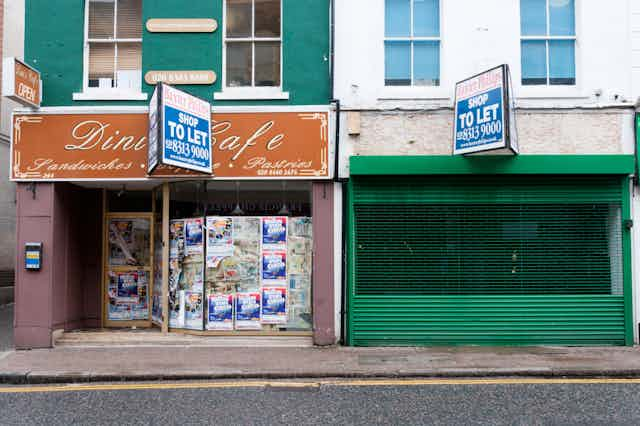The state of UK high streets has become shorthand for economic decline and the need to “level up”. And as small businesses face staggering rises in energy costs and households struggle with a cost-of-living crisis, this is likely to continue.
The “death of the high street” has become a well-worn political and economic trope. Government interventions have ranged from the Portas Review in 2011 to new powers in the Levelling Up and Regeneration Bill to repurpose vacant shops. Most recently, Rishi Sunak made reducing numbers of empty shops part of his pitch for the Conservative Party leadership.
My latest research suggests that businesses owned and led by community organisations and trading for social and commercial purposes could breathe new life into moribund town centres. They could stabilise declining high streets by bringing buildings back into use and providing activities that attract a wider range of customers.
But this research makes clear that we should not expect a quick fix. Community-led organisations need support in accessing buildings at a fair price so they can renovate them for new uses. This can be challenging when assets are held by absent landlords who are happy to hold out for an upturn in the commercial property market.
Achievable goals for making a difference
My study, commissioned by the Lottery-funded organisation Power to Change which supports community-led businesses, identifies three ways in which social purpose businesses can begin to make a long-term difference on high streets.
First, they can occupy a niche in time, leasing and re-using buildings on a “meanwhile” basis during a downturn in the market. The Meanwhile in Oxfordshire initiative, for example, is a programme run by Makespace Oxford to let out up to 30 vacant units across the county to community-based enterprises.
Second, they can occupy a niche in space, bringing landmark buildings back into use to create a new sense of vitality and identity – as has happened in Hebden Bridge, west Yorkshire, where the former town hall is now a hub for small businesses.
Third, they can create a niche in the market, bringing new activities into high streets to replace retail uses that are becoming obsolete because of changing tastes and the digitisation of shopping.
Examples include Future Yard, a music venue and learning space in Argyle Street, Birkenhead, and Hastings Commons, where community-based organisations have bought up a cluster of buildings in the East Sussex town’s historic Trinity Triangle and are repurposing them with a mix of arts, business, housing and community venues.
Overall, community-based organisations can assist a process of rethinking what creates value in a town centre. Instead of measuring value – as commercial property agents do – by the number of transactions and price per square metre achieved, value can be considered in terms of local businesses supported, jobs created, and the amount of time that members of the public spend there.
There are some emerging examples of coordinated action to rethink traditional high streets. Perhaps the most well-known is Midsteeple Quarter in Dumfries, southern Scotland, where a community benefit society is leading the redevelopment of a strategic block of high-street properties to create a mix of affordable accommodation, workshops, business space and arts studios.
More often, activity takes place on the margins of town centres, where swathes of property have been abandoned by the private market. In Villette Road, Sunderland, the community-led organisation Back on the Map is looking to buy up some of the street’s 14 empty shops. In Plymouth, Nudge Community Builders has brought four buildings back into use on Union Street, on the periphery of the city centre, with a café, food court and community venue.

Four-step support plan
Change is most likely to happen where community businesses can cluster together, creating a group of spaces and activities that become more than the sum of their parts. But this takes time and requires support. It has taken Hastings Commons – an initiative to transform the unique community area around the Observer building – 15 years to build up its cluster of activities, more often than not working under the radar and against the odds.
Four kinds of support are vital. These are:
1. Help in getting access to property at a fair price.
2. Financial support for community businesses, including at-risk funding for start-ups.
3. Supportive governance and regulation to give communities more of a say in their high streets.
4. Help for community organisations in building skills (such as property management) and networks.
Government can play an important part by strengthening community rights to buy property (Scotland is ahead of the rest of the UK here). It can provide funding for buildings at risk to enable organisations to take advantage of market opportunities. And it can also create funding programmes that work for communities rather than slavishly adhere to the monetary value of land rather than its social value.
These actions would be a start. In the long run, cross-party consensus is needed on reforming local government finance (including business rates) and landlord and tenant law to enable local authorities and communities to work together to tackle decline and dereliction.
There are many heartening success stories, but the malaise affecting our town centres and high streets is not simply the result of a market downturn. The way these places function has permanently changed, and now we must seize the opportunity to build the social value that will encourage people to live and remain there.
Central to that social value is a long-term shift in patterns of ownership, putting an increasing share of high-street property in the hands of organisations that are committed to community benefit.

